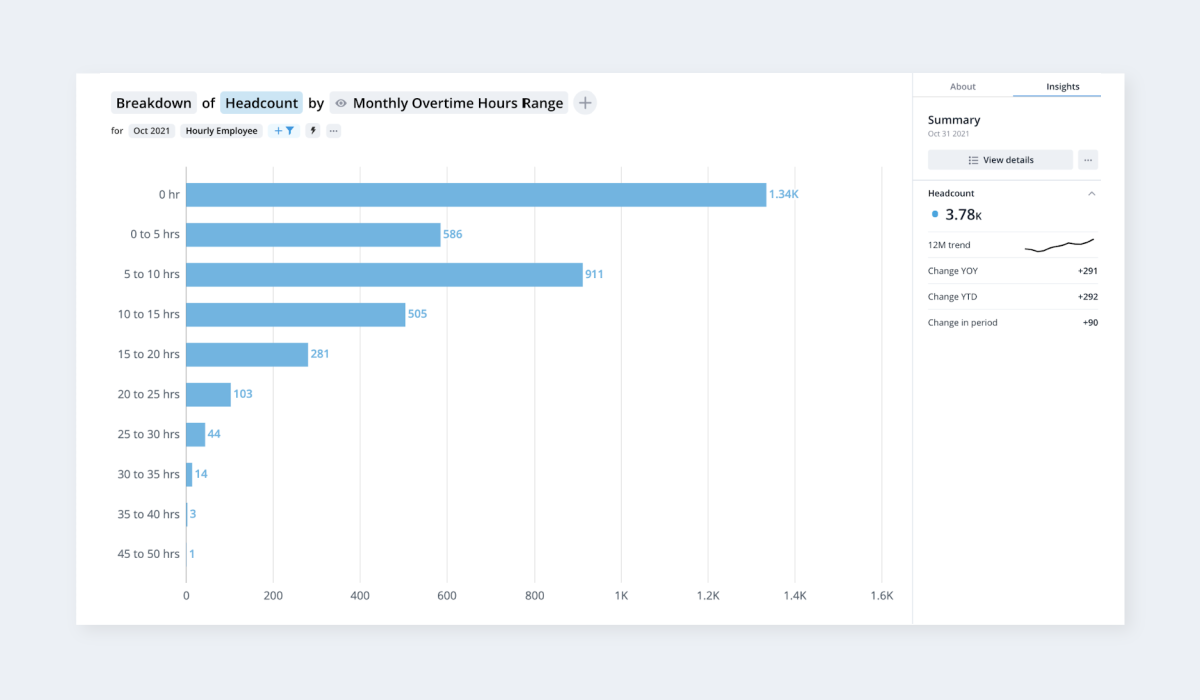Ask Visier: Are Any Employees Fatigued?
Are your employees fatigued? Even if they aren’t at the point of burnout, being overworked can cause retention and other problems. Jon Burton explains how Visier can help.

Ask Visier is a weekly column where a people analytics expert dives into one of the 2,000+ business questions available in Visier—and shares how to take action on the answers you might uncover on that topic.
Are any of your employees fatigued? Are they close to burnout? The current resignation wave suggests strongly that an increasing number of employees are dissatisfied with their employment situation. For some, this is a job mismatch, but there are increasingly regular stories of companies losing employees as of a result of long working hours and intense, overly intrusive quantifications of productivity (for example, not being allowed to take a bathroom break). Many of these roles suffering attrition are critical to the supply chain—warehousing and trucking to name a few—which means this simple problem has far-reaching effects.
Why should an HR pro want to know about employee fatigue?
The problems of employee fatigue go beyond attrition. An overly fatigued employee may be a risk in interacting with customers, be a safety risk, or impact employee morale by having other teammates pick up the slack when the fatigued employee just can’t do it any more. Each of these areas has a very real financial cost to the organization. In addition, employers that don’t push their employees to the point of fatigue gain a competitive advantage by attracting and retaining workers better and by being an employer of choice.
What can the data tell them about this?
One common way Visier clients measure fatigue is by overtime hours. While some employees enjoy the financial benefits of overtime pay, others get burned out by the requirement to work overtime. In this sample graph, you’ll see Visier can break this down further to show how many people are taking how many extra hours.
Another way Visier customers can find out if employees are feeling fatigued is through targeted engagement data with questions such as, “How reasonable is the workload for this role?” This will let you know if employees are starting to feel overburdened. This data can also be tracked over time to understand trends in sentiment.
A third approach Visier offers to uncover fatigue is by looking for long work streaks. Long work streaks are a set of consecutive days worked by an employee longer than a maximum limit set by your organization’s policy. Visier offers a long work streak metric, which shows the total number of work streaks longer than the policy. Visier can also show you a long work streaks ratio metric which shows the percentage of all work streaks that are longer than the maximum length.
These three metrics can go a long way towards uncovering when your employees are nearing burnout, and which areas of your company need the most attention.

This graph demonstrates the breakdown of monthly overtime hours employees worked.
What other questions or analysis should they do to get the full picture?
Once you have a basic understanding of the fatigue levels in your organization from the metrics above, you’ll want to find out how fatigue impacts employee safety, absences, customer satisfaction, and workforce costs by asking deeper questions.
For example:
Do groups with higher fatigue results have more safety incidents?
Do groups with higher fatigue results rely more on contractors to complete work?
Do groups with higher fatigue results have more absences than non fatigued groups?
Do groups with higher fatigue results have lower customer satisfaction scores?
By investigating deeper, you may discover that fatigue is a cause or at least a contributor to other issues affecting your company. Or, conversely, you may find it’s not as much a factor as you thought.

The graph shows the results of an employee survey on workload.
Why is it a challenge to answer this without Visier?
Visier offers out of the box metrics to assess fatigue tied to the employee level. We can then marry this fatigue data with other employee level data such as safety data, overtime, and absences. We can also compare this fatigue data to business results such as net promoter scores. By being able to see the fatigue data at the employee level and being able to aggregate this up into key groupings (for example: department, region, or age cohort) you can learn which groups are most affected. This can help you create targeted mitigation strategies.

This graph shows the breakdown of annual hours employees worked.
Being able to show the correlation between fatigue and unwanted metrics such as poor customer service or higher safety violations will help prove the value of these mitigation strategies to C-suite executives who may not understand the true business cost associated with fatigue.
The first step in getting better is accurate diagnosis of the problem. Once you have a good picture of how fatigued your employees are, and what effect that’s having on outcomes, you can take steps to address the issues. Without this kind of visibility, you might not know you have a problem until numerous people in critical roles start giving notice, or until the overwork causes accidents. If your employees are too proud or afraid to speak up when the workload is getting to them, the data can tell their story.
Continue learning about employee burnout:
Get Outsmart content straight to your inbox
Subscribe to the People Insights Monthly newsletter for actionable insights and stories.
Subscribe now